This site uses cookies as defined in our Cookie Policy, by continuing to use this site you agree to their use.
Continue
| Arrive | Depart | ||||||
| 13th13 | JanJan | 202828 | Bridgetown, Barbados, embark on the Emerald Azzurra | ||||
Located beside the island’s only natural harbour, the capital of Barbados combines modern and colonial architecture with glorious palm tree-lined beaches and a number of historical attractions. Experience the relaxed culture of the city renowned for its British-style parliament buildings and vibrant beach life, and seek out the Anglican church and the 19th-century Barbados Garrison. The distance between the ship and your tour vehicle may vary. This distance is not included in the excursion grades. Your Caribbean cruise begins in alluring Barbados and its bustling capital, Bridgetown. From here, you’ll be transferred to your Emerald Cruises luxury yacht and embark on an exciting voyage in search of paradise and adventure. Please book your flight to arrive into Bridgetown prior to 04:00 PM. | |||||||
| 14th14 | JanJan | 202828 | Port Elizabeth, Bequia, Saint Vincent and the Grenadines | ||||
Bequia is a Carib word meaning "island of the cloud." Hilly and green with several golden-sand beaches, Bequia is 9 miles (14½ km) south of St. Vincent's southwestern shore; with a population of 5,000, it's the largest of the Grenadines. Although boatbuilding, whaling, and fishing have been the predominant industries here for generations, sailing has now become almost synonymous with Bequia. Admiralty Bay is a favored anchorage for both privately owned and chartered yachts. Lodgings range from comfortable resorts and villas to cozy West Indian—style inns. Bequia's airport and the frequent ferry service from St. Vincent make this a favorite destination for day-trippers, as well. The ferry docks in Port Elizabeth, a tiny town with waterfront bars, restaurants, and shops where you can buy handmade souvenirs—including the exquisitely detailed model sailboats that are a famous Bequia export. The Easter Regatta is held during the four-day Easter weekend, when revelers gather to watch boat races and celebrate the island's seafaring traditions with food, music, dancing, and competitive games.To see the views, villages, beaches, and boatbuilding sites around Bequia, hire a taxi at the jetty in Port Elizabeth. Several usually line up under the almond trees to meet each ferry from St. Vincent. Today, you’ll discover Bequia Island, a hidden paradise amid Saint Vincent and the Grenadines, revealing tranquil, secluded spots and a distinct lack of traffic. This beautiful island offers visitors a chance to experience an authentic Caribbean lifestyle, without the hustle and bustle of mainstream beach tourism. Delight in exploring untouched pristine beaches and truly relax and unwind in stunning nature. | |||||||
| 15th15 | JanJan | 202828 | Mayreau Island, Saint Vincent and the Grenadines | ||||
The small island of Mayreau, just one and 1/2 square miles in area (3.9 square kilometres) is the smallest inhabited island of The Grenadines, and is part of the independent state of St.Vincent in the eastern Caribbean Sea. Two of the best known islands in The Grenadines are Mustique and Bequia, the second largest island in this group. The Grenadine Islands are strung out in a gentle sweep between St.Vincent and Grenada. Most visitors to Mayreau arrive from cruise ships, on the regular ferry, or by yacht. There are no proper roads on the island, only a few vehicles, no airport and only a single unnamed village. Mayreau and the neighboring Tobago Cays are very popular for divers and snorkellers. Saline Bay, on the west coast of the island, has a wonderful broad beach and a few local vendors selling T-shirts and local craft. A climb up the road to the hilltop village on the island provides breathtaking views across Mayreau, Canouan, the Tobago Cays and Carriacou. Welcome to Mayreau, the smallest of the Grenadines’ uninhabited islands, with a surface area of just four-square kilometres (1.5-square miles). The population of Mayreau is no more than 250 residents, who live in the village located on the island’s highest point, Station Hill. The charming little church and community centre at the top of the hill provide spectacular views across the islands. On a clear day, you can observe both Grenada and Saint Vincent, as well as other nearby islands, showcasing the vivid colours of the reefs and waters surrounding the Tobago Cays. | |||||||
| 16th16 | JanJan | 202828 | At Sea | ||||
| 17th17 | JanJan | 202828 | Kralendijk, Bonaire | ||||
This island group makes an attractive destination for nature lovers and eco-tourists alike, as all the islands offer excellent opportunities for snorkelling and swimming, as well as hiking. Bonaire, just off the north coast of Venezuela, is famous for its pioneering conservation efforts, with a large section of the island under protection status. Today, enjoy exploring Kralendijk, the colourful capital of Bonaire, famous for its heritage architecture and lovely sandy beaches. In the evening, you’ll set sail for Willemstad. | |||||||
| 18th18 | JanJan | 202828 | Willemstad, Curaçao | ||||
Dutch settlers came here in the 1630s, about the same time they sailed through the Verazzano Narrows to Manhattan, bringing with them original red-tile roofs, first used on the trade ships as ballast and later incorporated into the architecture of Willemstad. Much of the original colonial structures remain, but this historic city is constantly reinventing itself and the government monument foundation is always busy restoring buildings in one urban neighborhood or another. The salty air causes what is called "wall cancer" which causes the ancient abodes to continually crumble over time. The city is cut in two by Santa Anna Bay. On one side is Punda (the point)—crammed with shops, restaurants, monuments, and markets and a new museum retracing its colorful history. And on the other side is Otrobanda (literally meaning the "other side"), with lots of narrow, winding streets and alleyways (called "steekjes" in Dutch), full of private homes notable for their picturesque gables and Dutch-influenced designs. In recent years the ongoing regeneration of Otrobanda has been apparent, marked by a surge in development of new hotels, restaurants, and shops; the rebirth, concentrated near the waterfront, was spearheaded by the creation of the elaborate Kura Hulanda complex.There are three ways to cross the bay: by car over the Juliana Bridge; by foot over the Queen Emma pontoon bridge (locally called "The Swinging Old Lady"); or by free ferry, which runs when the pontoon bridge is swung open for passing ships. All the major hotels outside town offer free shuttle service to town once or twice daily. Shuttles coming from the Otrobanda side leave you at Riffort. From here it's a short walk north to the foot of the pontoon bridge. Shuttles coming from the Punda side leave you near the main entrance to Ft. Amsterdam. The charming capital of Curaçao, Willemstad, is a vibrant port city renowned for its stunning blend of culture, rich history, and colourful architecture. Nestled along the southern coast of the island, Willemstad is divided into two main districts, Punda and Otrobanda, which are connected by the iconic Queen Emma Bridge, a pontoon bridge that swings open for ocean-going ships. | |||||||
| 19th19 | JanJan | 202828 | Oranjestad, Aruba | ||||
Aruba's capital is easily explored on foot. Its palm-lined central thoroughfare runs between old and new pastel-painted buildings of typical Dutch design (Spanish influence is also evident in some of the architecture). There are a lot of malls with boutiques and shops—the Renaissance mall carries high-end luxury items and designer fashions. A massive renovation in downtown has given Main Street (a.k.a. Caya G. F. Betico Croes) behind the Renaissance Resort a whole new lease on life: boutique malls, shops, and restaurants have opened next to well-loved family-run businesses. The pedestrian-only walkway and resting areas have unclogged the street, and the new eco-trolley is free and a great way to get around. At this writing, Linear Park was well and will showcase local merchants and artists. There will be activities along a boardwalk that will eventually run all the way to the end of Palm Beach, making it the longest of its kind in the Caribbean. Today, you’ll arrive in the capital of Aruba, Oranjestad, a unique blend of old and modern that lends a special charm to this c bustling harbour city. Leisurely stroll along the streets lined with a variety of boutiques and striking residential buildings. Among the remarkably well-preserved buildings is the green ‘Stadhuis,’ which houses the City Hall. Another interesting siteis the Aloe Museum and Factory, which dates back to 1890 and illustrates the fascinating story of aloe production, on which the economy was once dependent. | |||||||
| 20th20 | JanJan | 202828 | Santa Marta, Colombia | ||||
The welcome sign to Santa Marta reads, “Here you can have it all”. Alongside its beautiful beaches and vibrant city life, Santa Marta boasts a rich history and culture – the oldest remaining city in Colombia, dating back to 1525 and the nation’s first Spanish settlement. | |||||||
| 21st21 | JanJan | 202828 | Cartagena, Colombia | ||||
Cartagena's magnificent city walls and fortresses, now a UNESCO World Heritage Site, enclose a well-restored historic center (the Cuidad Amurallada, or walled city) with plazas, churches, museums, and shops that have made it a lively coastal vacation spot for South Americans and others. New hotels and restaurants make the walled city a desirable place to stay, and the formerly down-at-the-heels Getsemaní neighborhood attracts those seeking a bohemian buzz. The historic center is a small section of Cartagena; many hotels are in the Bocagrande district, an elongated peninsula where high-rise hotels overlook a long, gray-sand beach.When it was founded in 1533 by Spanish conquistador Pedro de Heredia, Cartagena was the only port on the South American mainland. Gold and silver looted from indigenous peoples passed through here en route to Spain and attracted pirates, including Sir Francis Drake, who in 1586 torched 200 buildings. Cartagena's walls protected the city's riches as well as the New World's most important African slave market. Located along the coast of the Caribbean Sea, Cartagena de Indias uniquely combines the charm of colonial architecture and the vibrancy of modern life. This dynamic port city is well- known for its fascinating cultural festivals, breathtaking landscapes and excellent cuisine. It also bears the legacies of storied Latin American history within its UNESCO World Heritage-listed walled Old Town and narrow stone walkways. As one of the most well-preserved cities in the Americas, Cartagena de Indias has inspired many artists throughout the ages. | |||||||
| 22nd22 | JanJan | 202828 | San Blas Islands, Panama | ||||
The San Blas archipelago is located off the Caribbean coast, east of Colon, and is made up of 365 islands that range in size from tiny ones with a few coconut palms to islands on which hundreds of Kuna Indians live. Only about fifty are inhabited. The Kuna rule the San Blas Territory with internal autonomy, and have tightly preserved their language and cultural traditions over the centuries despite influences from European colonies. In addition to their own language, Spanish is widely spoken and many men work on the mainland, but live on the islands. Women wear costumes with unique designs based on local themes, geometric patterns, and stylised fauna and flora. The island of El Porvenir is one of the main seats of government for the Kuna Indians. Many Kunas from the other islands came to settle on El Porvenir, bringing with them their traditional arts and crafts, including the famous molas. These intricately hand-sewn designs are made by the women of the tribes as part of their blouses and dresses. With the increased tourism, molas are now a favoured souvenir and craft item for visitors. Welcome to the San Blas archipelago, a group of islands located just north-west of Panama in the sparkling Caribbean Sea. There are 378 islands within the archipelago, spread across an area of roughly 259-square-kilometres (100-square-miles). Most of these islands are uninhabited, but on some of the larger ones, you may get an opportunity to meet the native people, known as the Kunas. Formally called Kuna Yala (”Land of the Kuna”), San Blas is an autonomous territory of Panama, famed for its untouched nature and traditional culture. | |||||||
| 23rd23 | JanJan | 202828 | At Sea | ||||
| 24th24 | JanJan | 202828 | Panama City, Panama | ||||
Expect incredible morning views as you arrive into the port for Panama City. Tinged with a silver pre-dawn light, the city will metamorphosise into a golden glow as the sun rises above it. And from then on expect one stunning view after another. Very interesting in its own right, Fuerte Amador is obviously overshadowed by its proximity to Panama City. So should the Miraflores museum of the Canal, which offers a comprehensive and immersive tour of the Canal including a 3-D experience, four exhibition halls, an observation deck, and a surprisingly good restaurant not interest you then there is always the option of lovely Casco Viejo – literally the old quartier of Panama. The grand old colonial houses, cobbled streets, independent boutiques and buzzing street scene make this a must stop on your itinerary. And if you like seafood, you will not want miss the many restaurants and market stalls serving different variations of so-fresh-it’s-still-practically-swimming ceviche. Best eaten like the Panamanians do, with salty crackers and a cold beer on the beach. And if money is no object, a cup of geisha coffee – supposedly the world’s best and definitely the world’s most expensive at $7 a shot is definitely a pick me up! Cool cosmopolitan capital aside, Panama has a skyscraper filled skyline that is worthy of some of its North American counterparts. But if urban utopia is not your scene then fear not, the sandy beaches and lush rainforests are never more than a short cab ride away. After breakfast, you’ll have time to explore Panama City, the capital of Panama. Framed by the Pacific Ocean, Panama’s largest city boasts a historic old centre, Casco Viejo, which charms visitors with its cobblestoned streets, colonial-era landmarks and pretty plazas lined with cafés and bars. | |||||||
| 25th25 | JanJan | 202828 | Pearl Islands, Panama | ||||
Today, you’ll discover the Pearl Islands, located on the Pacific Coast of Panama, in the Gulf of Panama. Cruise to one of the 200 or so islands and islets, many of them, tiny and uninhabited, and enjoy the superb beaches and beautiful coral reefs. The waters are alive with vibrant tropical fish and an incredible diversity of marine life, offering a captivating glimpse into the region’s rich underwater world. | |||||||
| 26th26 | JanJan | 202828 | Playa del Muerto, Panama | ||||
The Darién National Park is a UNESCO World Heritage-listed Site covering approximately 5,750-square kilometres (2,220-square miles). This vast park is among the largest and most precious protected areas in Central America, extending across almost the entire Panama-Colombia border, as well as a stretch to the Pacific Ocean. Darién National Park offers an exceptional variety of habitats – sandy beaches, rocky coasts, swamps, mangroves, and tropical forests – which makes it a rich and welcoming habitat for diverse wildlife. There are two indigenous tribes known to both Panama and Costa Rica, which today, reside along the park’s riverbanks. | |||||||
| 26th26 | JanJan | 202828 | Darién National Park, Panama | ||||
"The remote Darien Jungle has one of the most biodiverse ecosystems in the world. It is also one of the world’s top ten birding sites, with the colourful Crimson-collared Tanager, Chestnut-fronted Macaws, and Snow-bellied Hummingbirds found here. Mammals include tapirs and Black-headed Spider Monkeys. In this roadless stretch of forest, rivers provide the best access. Visitors to the Darien Jungle are rare with fewer than 1,000 tourists visiting each year. The Embera are one of several indigenous groups that live here in relative isolation offering ornate handcrafted baskets and carvings for sale in their traditional villages." | |||||||
| 27th27 | JanJan | 202828 | Cébaco Island, Panama | ||||
Welcome to Cebaco Island, which lies in the province of Veraguas and is part of the buffer zone of Coiba Island National Park. Cebaco is Panama’s third-largest island after Coiba Island and Isla del Rey. It is estimated there are around 500 residents living on the island, mainly distributed in communities in the northern parts. Isla Cebaco is also popular for its gorgeous beaches. | |||||||
| 28th28 | JanJan | 202828 | Golfito, Costa Rica | ||||
Golfito, is situated along a small inlet of Golfo Dulce. This small port city is a narrow strip along Golfito Bay backed against steep green hills covered with pristine rainforest, with the Golfo Dulce seaward outside Golfito Bay. Surrounded by tropical rainforest, Golfito provides an ideal location to escape from your hectic schedule and enjoy some of the most beautiful beaches in Costa Rica with a stunning backdrop of verdant hills and lush rainforest. Follow a trail through the densely forested Golfito National Wildlife Refuge to observe rare flora and fauna, and emerge at a scenic outlook with views of the ocean, also the city has a variety of hotels and restaurants, many of which now provide free wireless Internet service for customers. Golfito was the main port on the South Pacific Coast of Costa Rica in the days when there was little except for the huge banana plantations. To help remedy the resulting economy decrease of the region, the government established a duty-free zone, support and impulse the touristic development. Golfito Bay is a ‘gulf within a gulf,’ well-known for its unspoiled landscapes framed by the lush mangroves of Corcovado and Piedras Blancas national parks. It’s home to some of the richest biodiversity on the planet and lies within one of the most vibrant destinations in Costa Rica. Here, eco-adventurers, boaters, surfers, and outdoor lovers come to explore and connect with nature, enjoying an array of fun and exciting activities. A hidden gem where the Costa Rican jungle meets the sea, Marina Golfito invites you to experience Costa Rica from a stunning new perspective. | |||||||
| 29th29 | JanJan | 202828 | Quepos (Puerto Quepos), Costa Rica | ||||
Quepos allows tourists to experience a once in a lifetime nature experience in Manuel Antonio National Park without leaving any of the familiar amenities behind. The close proximity of the park, located just 4.3 miles (7 km) to the south, and a wide array of services makes Quepos the perfect place to visit for those who wish to explore this enchanting area. The amenities available include everything from banks, restaurants, hotels, gift shops, bakeries, bars, a hospital, supermarket and even a post office. The area was once dependent on banana plantations which used to line the surrounding area. After disease infiltrated the harvest, interest transferred to African Palms as the prominent crop. Now, tourism has deemed itself the major economic factor, contributing to just about everything in the area. Quepos lures in many tourists for its fantastic sport fishing. In fact, some have come solely to participate in this world class experience and have never left, but besides sport fishing, many other activities are available. Exploring this maze of wetlands by boat is amazing but not the only way to see crocodiles, monkeys, herons, raccoons and more. This small paradise has the perfect balance between nature and the comfort and facilities someone might need. Today, you’ll arrive in Quepos, a small, booming harbour town, popular as one of the prime spots for sport fishing, as well as the gateway to the renowned Manuel Antonio National Park. As a tropical inlet backed by rainforest, the park offers a variety of outdoor adventures. After the decline of the banana plantation that laid the original foundations for the port, Quepos replaced its former industry with ecotourism – meaning, there are now many other attractions to enjoy. Quepos is also frequented by numerous scientists and naturalists, who come to study this region's fantastic biodiversity. | |||||||
| 30th30 | JanJan | 202828 | Tortuga Island, Costa Rica | ||||
Named after its turtle-shaped volcanic rock formations, Isla Tortuga is a small island set just off the tip of Nicoya Peninsula’s southern coast. The island offers a unique combination of white pristine beaches, palm trees, red volcanic rocks, verdant jungles and sparkling crystals that line the shores. Sunlight reaches right through the crystal clear waters at Isla Tortuga, making it a sought-after destination for snorkelers and scuba divers. Just east of the island is the Curu Wildlife Refuge offers some of the region’s best wildlife watching, including sightings of capuchin and howler monkeys, river otters, and deer on the ground, and a diverse ecology of underwater wildlife that can be accessed via snorkeling. Most commonly seen species are mantarays, reef sharks, octupus, stingrays, angle fish and spinner dolphins. The Curú National Wildlife Refuge and Farm are situated in Nicoya Peninsula, in north-west Costa Rica. Some of the country’s most beautiful beaches and protected bays can be discovered here. Costa Rica’s first private national wildlife refuge is a prime example of a successful sustainable development program. You can still see cattle grazing here, as well as tropical fruits cultivated, such as mangoes. | |||||||
| 31st31 | JanJan | 202828 | Puerto Caldera, Costa Rica, disembark the Emerald Azzurra | ||||
Today, your time on board your Emerald Cruises luxury yacht comes to an end in the port city of Puerto Caldera, Costa Rica. After bidding farewell to the crew and your fellow guests, you’ll be transferred to the airport for your return flight home, or to continue your holiday. Please book your flight to depart out of San Jose after 01:00 PM. The itinerary is a guide only and may be amended for operational reasons. As such Emerald Cruises cannot guarantee the cruise will operated unaltered from the itinerary states above. Please refer to our terms and conditions for further information. | |||||||
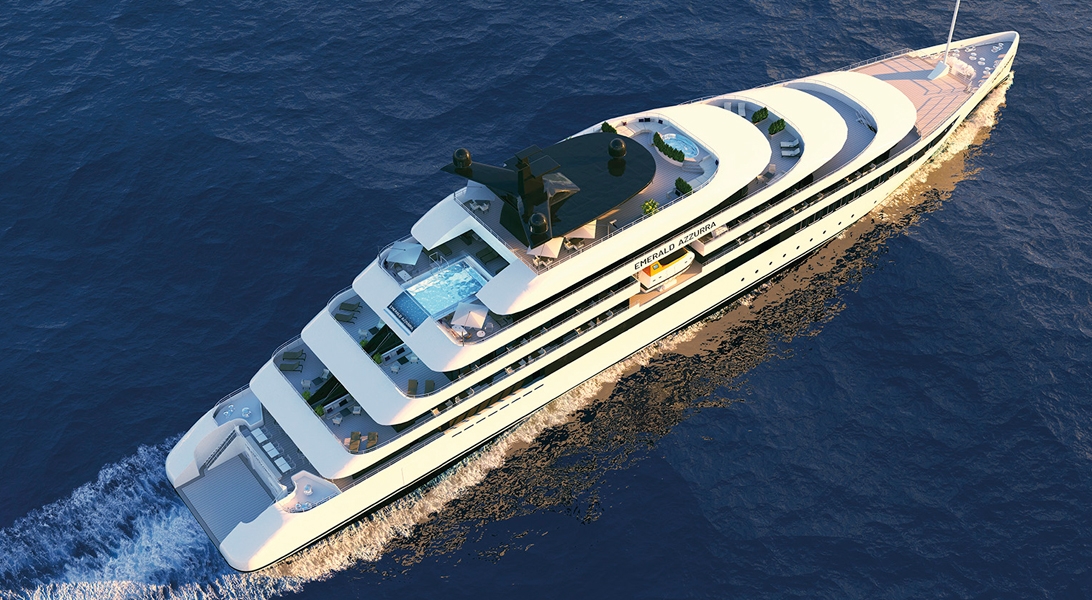
The images shown are for illustration purposes only and may not be an exact representation of what you find on the ship.
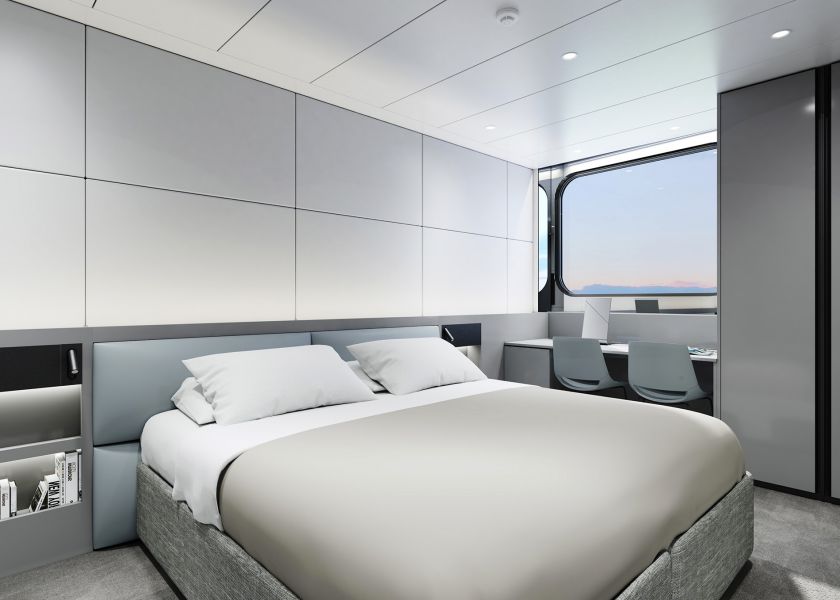
Situated on the Emerald Deck, towards the front of the yacht, our Oceanview Staterooms are bigger than the average standard, offering excellent value for money.
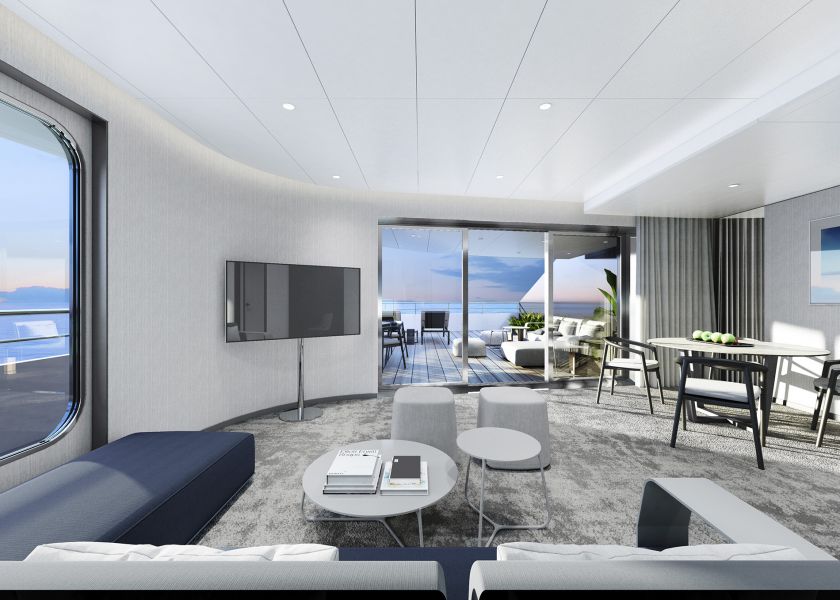
Our oversized Owner’s Suites are the largest and most opulent, located on the Pool Deck. Boasting a separate bedroom and lounge area, you’ll also enjoy your large private terrace, from which to admire the stunning views of each port you visit.
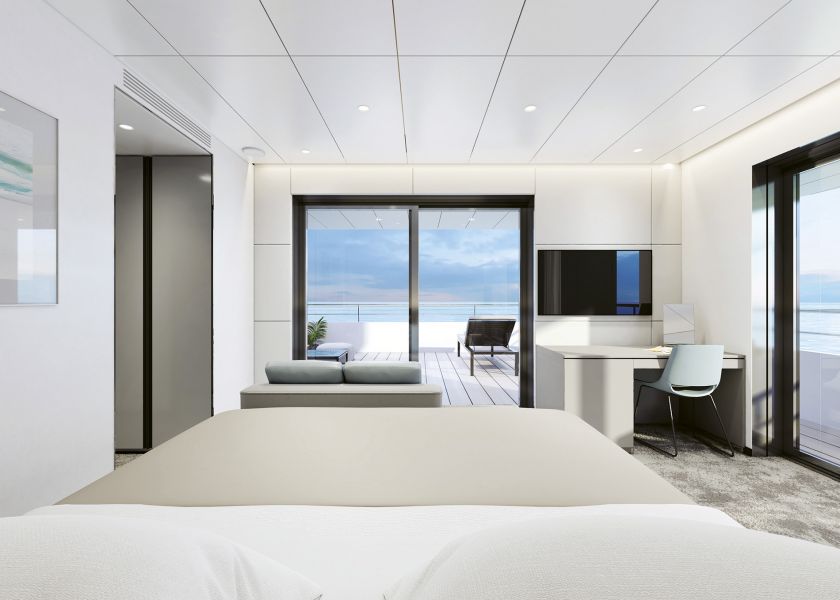
Our spacious Terrace Suites take pride of place at the back of the Panorama Deck and come complete with a large private terrace, pillow menu and the option to have two items laundered daily, perfect for preparing your wardrobe for a special occasion.
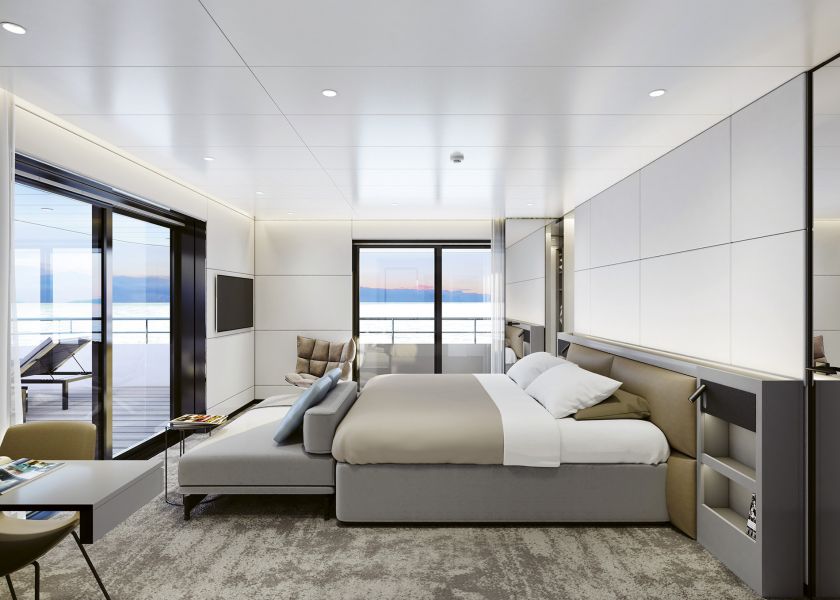
Positioned at the back of the Observation Deck, you’ll be treated to sensational ocean and coastal views from your own private terrace. You’ll also receive a number of luxury inclusions to help you make the most of your time in your Yacht Suite.
The images shown are for illustration purposes only and may not be an exact representation of what you find on the ship.
The images shown are for illustration purposes only and may not be an exact representation of what you find on the ship.
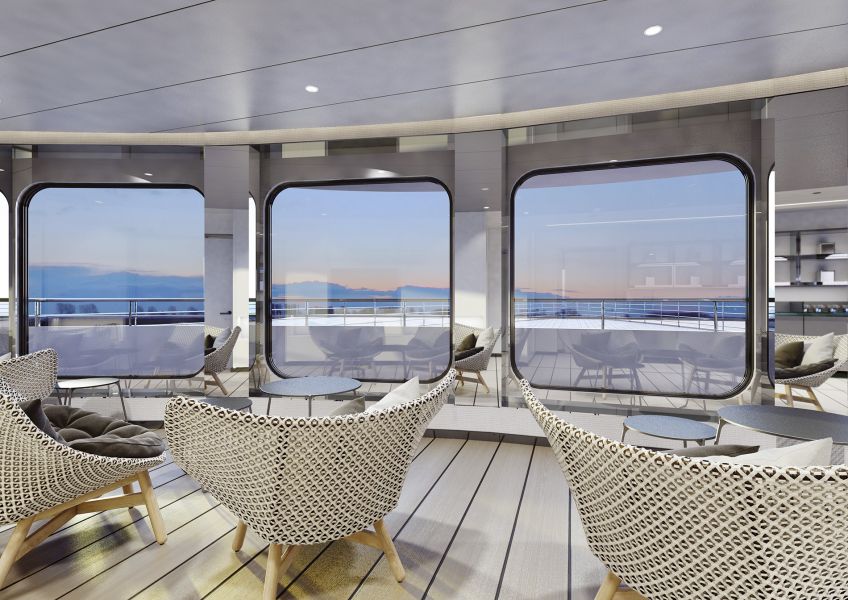
Head to the Observation Deck area for spectacular views or a morning yoga session. In the Observation Lounge, sit back and relax with a good book or play a game of chess.
The images shown are for illustration purposes only and may not be an exact representation of what you find on the ship.
The images shown are for illustration purposes only and may not be an exact representation of what you find on the ship.
| Return flights including luggage allowance | |||
| Overseas Transfers | |||
| 18 nights aboard the Emerald Azzurra | |||
| Return airport transfers | |||
| Wine, beer & soft drinks with lunch & dinner | |||
| Gratuities Included | |||
| One complimentary shore excursion in every port | |||
| Bikes for passenger use | |||
| Free Wi-Fi included | |||
| Port Taxes and Fees | |||
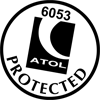 | ABTA and ATOL Protection* | ||
Fly/cruise package |
Date 13th Jan 2028 |
Nts 18 |
Interior  |
Oceanview £15,507pp |
Balcony  |
Suite £19,013pp |
Interior  |
Oceanview £31,014pp |
Balcony  |
Suite £34,520pp |
Date 13th Jan 2028 |
Nts 18 |
Interior  |
Oceanview £15,507pp |
Balcony  |
Suite £19,013pp |
Interior  |
Oceanview £31,014pp |
Balcony  |
Suite £34,520pp |




Fusion Cruises when selling travel arrangements is a trading name of The Midcounties Co-operative Ltd. Fusion Cruises is an Accredited Body Member of Midcounties Co-operative Travel Consortium. (ABTA:P6652, ATOL:6053).
Book with Confidence. We are a Member of ABTA which means you have the benefit of ABTA’s assistance and Code of Conduct.
Some of the flights and flight-inclusive holidays on this website are financially protected by the ATOL scheme but ATOL protection does not apply to all holiday and travel services offered on this website. This website will provide you with information on the protection that applies in the case of each holiday and travel service offered before you make your booking. If you do not receive an ATOL Certificate then the booking will not be ATOL protected. If you do receive an ATOL Certificate but all parts of your trip are not listed on it, those parts will not be ATOL protected. Please see our booking conditions for information, or for more information about financial protection and the ATOL Certificate go to: www.caa.co.uk
